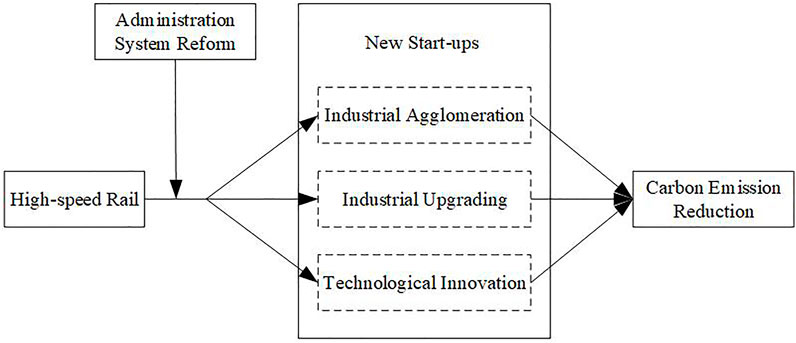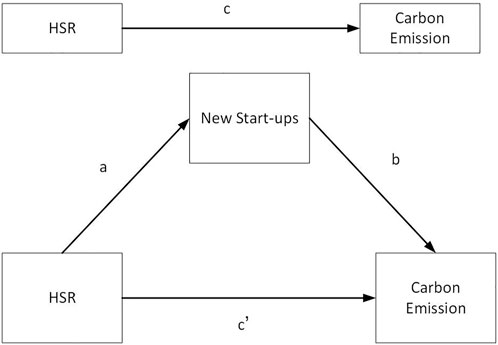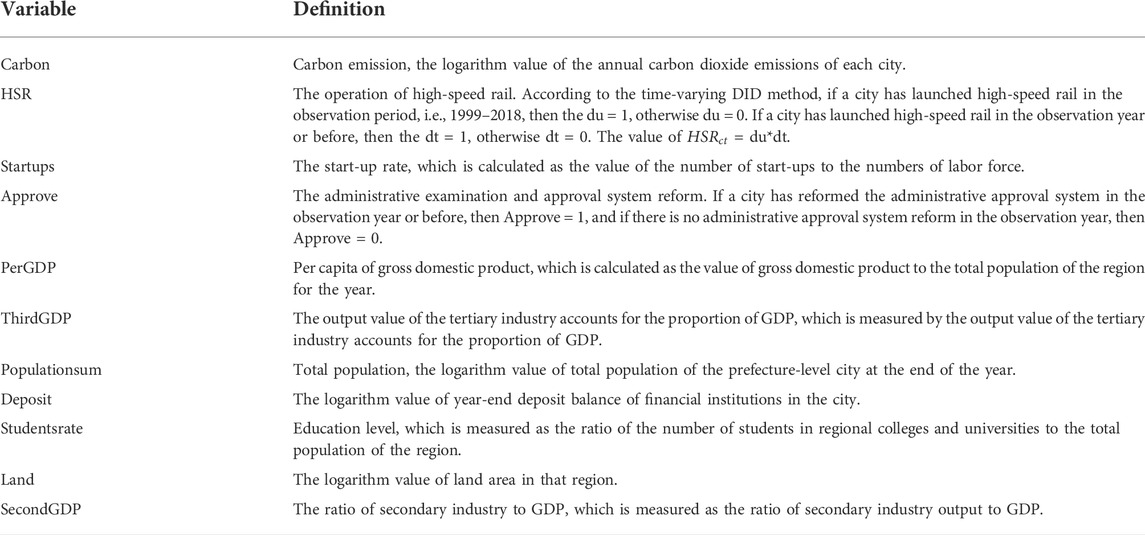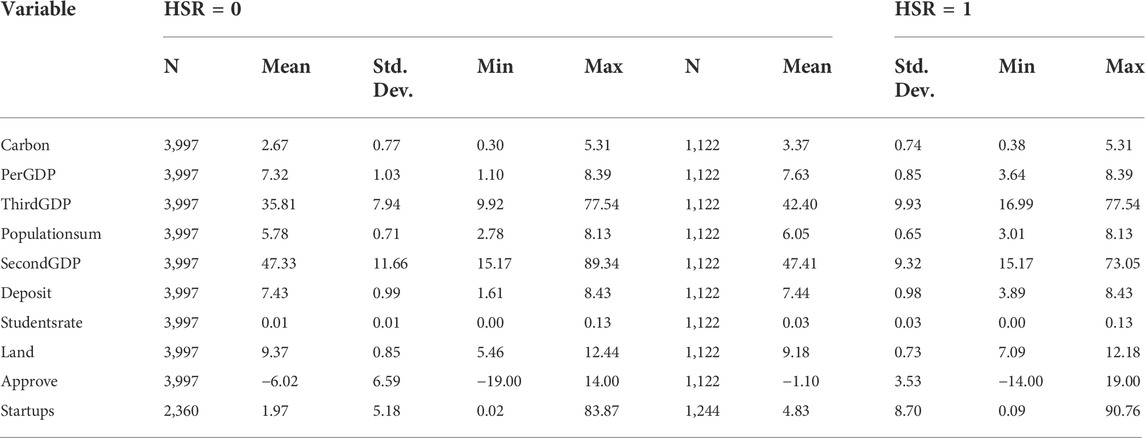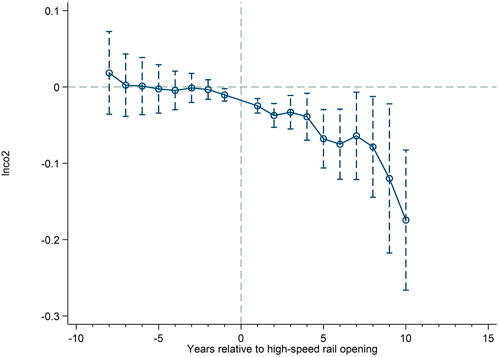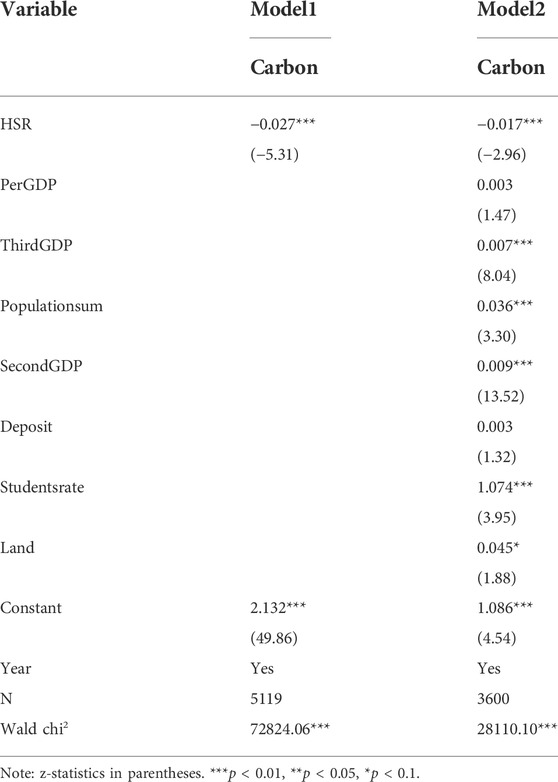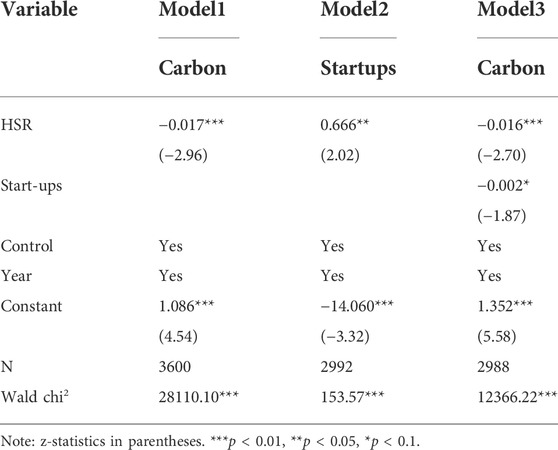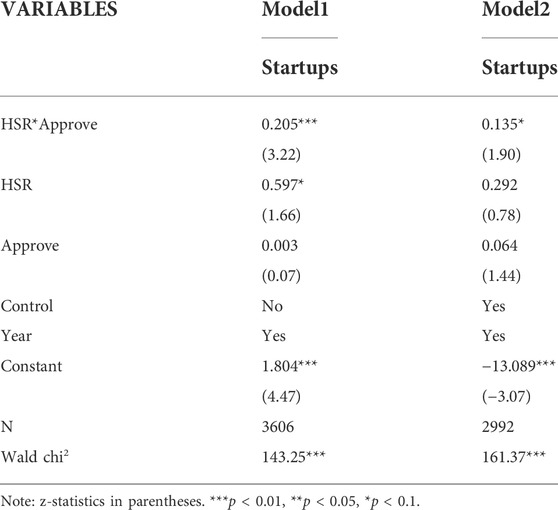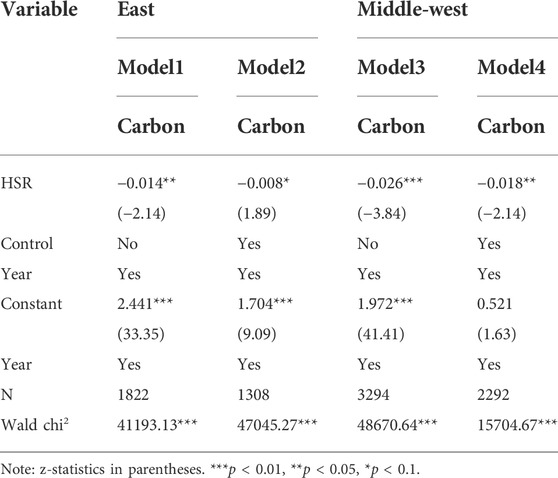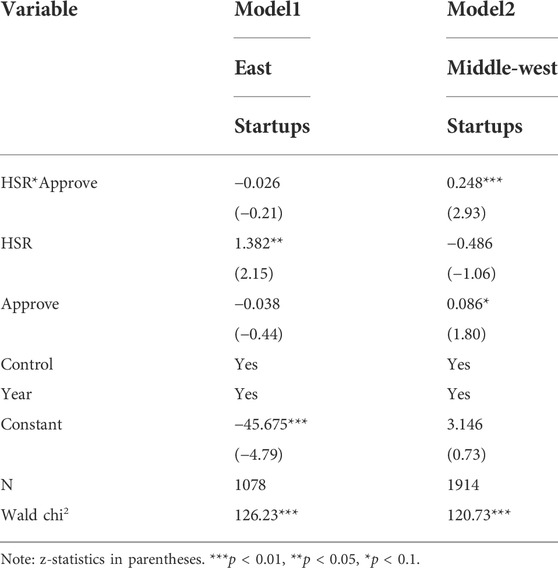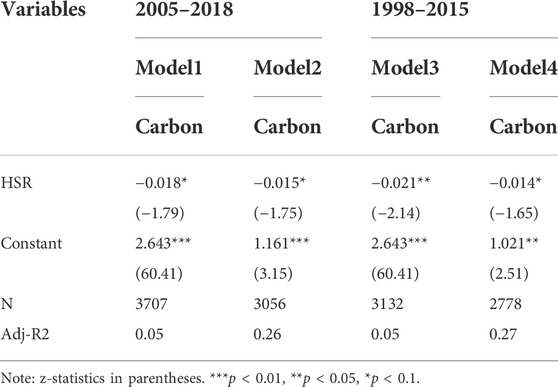- 1College of Economics and Management, Zhejiang University of Water Resources and Electric Power, Hangzhou, Zhejiang, China
- 2Business School, Sichuan University, Chengdu, Sichuan, China
Prior studies document that the development of transportation infrastructure, particularly the rapid development of high-speed rail, plays a key role in transforming an economy towards a low-carbon development mode, for example by reducing carbon emissions in China and other countries. However, to date, the mechanisms and paths that link high-speed rail to carbon emission reduction remain ambiguous. The present study seeks to clarify this path by proposing the mediating role of entrepreneurship, arguing that the rapid cycle of people, capital, knowledge, and technology induced by high-speed rail would be integrated by entrepreneurs as new start-ups, leading to industry agglomeration, upgrading, and innovations. These consequences of entrepreneurship would further result in carbon emission reductions. Employing a unique dataset in China, we provide strong evidence for our arguments by setting China’s prefecture-level cities as the unit of analysis. The research conclusions are as follows: First, the launch of high-speed rail services has a positive effect on a city’s carbon emission reduction. Second, entrepreneurship plays a mediating role in the relationship between high-speed rail and carbon emission reduction. Third, the administrative approval system reform would strengthen the effect of high-speed rail on entrepreneurship. This study therefore clarifies the path through which high-speed rail leads to carbon emission reduction, and reconfirms the role of transportation development in achieving the goal of sustainable development towards carbon neutrality.
1 Introduction
Global warming, which has become a major challenge to sustainable development, is mainly caused by carbon emissions, and has received widespread attention from the international community (Francey et al., 2013; Zhang and Da, 2015). China, as the country with the highest CO2 emissions, has proposed a series of carbon reduction targets to deal with climate change. For example, at the 75th UN General Assembly in 2020, China unveiled its aim to reach peak CO2 emissions by 2030 and carbon neutrality by 2060. China’s Fifth Plenary Session of the 19th Central Committee held in October 2020 proposed the wide implementation of a green production and lifestyle by 2035, leading to a steady decrease in carbon emissions after reaching the peak. Because low-tech and energy-intensive industries currently contribute to a high proportion of China’s development, improving the quality of the ecological environment and reducing carbon emissions remain important tasks for China’s economy in the “new normal” phase.
As a low-energy green transportation tool, high-speed rail (HSR) is an important part of the infrastructure to reduce carbon emissions in the transportation industry, and has developed rapidly in recent years. By the end of 2021, the total mileage of China’s high-speed railway exceeded 40000 km, and is expected to reach the goal of covering 98% of the urban population of more than half a million cities by 2025. Meanwhile, scholars have also noted that high-speed rail is beneficial to reducing carbon dioxide emissions. In their analysis of the policy of canceling short-medium-haul air routes at the pan-European level, Avogadro et al. (2021) found that about 26.5 million (3.02% of intra-European) offered seats may be cancelled and substituted by high-speed rail, without any significant increase in passengers’ travel time. Jia et al. (2021) calculated that every 100 additional HSR trains in a city reduce its total carbon dioxide emissions by 0.14%.
At present, a large number of scholars have discussed the impact of high-speed rail on industrial agglomeration, industrial upgrading, and technological innovation. For example, Murakami and Cervero (2012) and Shao et al. (2017) proposed that knowledge-intensive, time-sensitive, and tourism-based industries that rely on personnel mobility were more susceptible to the impact of high-speed rail, thus producing an agglomeration effect. The research of Lin (2017) and Wang et al. (2019) showed that the operation of HSR can promote the upgrading of industrial structure to service and improve the quality of regional urbanization. Yang et al. (2021) showed that HSR significantly promoted innovation growth and innovation convergence, and the effect values were 14.73% and 5.91%, respectively. Tang et al. (2022) proposed that high-speed rail can significantly increase total factor production efficiency and human capital level. Xiao et al. (2022) indicated that high-speed rail has a robust positive impact on intercity technology transfer through geographical proximity, industrial proximity, innovation proximity, and technology complementarity. Whether high-speed rail will produce economic behavior in the market through industrial agglomeration, industrial upgrading, and technological innovation—thereby reducing urban carbon emissions—is a research topic worthy of discussion.
These effects of high-speed rail have created extensive entrepreneurial opportunities. On the basis of industrial structure upgrading, HSR has a more obvious role in promoting entrepreneurship in the tertiary industry, which will have an impact on the ecological environment. The most intuitive embodiment of eco-environmental quality is the influence on carbon emissions. Zhao et al. (2015) believed that high-speed rail can help optimize industrial structure and produce significant energy conservation and emission reduction effects, while promoting economic growth. Based on the industrial agglomeration effect of high-speed rail, Zhao and Lin (2019) deeply analyzed the nonlinear relationship between industrial agglomeration and energy efficiency based on provincial panel data for the textile industry. Yang et al. (2019) proved that high-speed rail effectively reduced environmental pollution through technical effects, allocation effects, and substitution effects. Among them, technical effects refer to the technological progress brought about by resource sharing; allocation effect represents the resource allocation optimization formed by resource flow; and substitution effect refers to the industrial structure substitution produced by the improvement of resource utilization. Dong X. et al. (2020) showed that high-speed rail can promote optimal resource allocation for productivity in a larger space and improve the human resource level of cities along the line. Wang et al. (2020) and Wang et al. (2022) verified the intermediary role of industrial agglomeration in the relationship between transportation infrastructure and energy efficiency. Huang and Wang (2020) found that high-speed rail was conducive to improving both original and new technology, so as to realize carbon emission reduction and cleaner production by creating a more active innovation and entrepreneurship ecosystem. Dong K. et al. (2020), Ren et al. (2021), and Cheng et al. (2021) tested the impact of natural gas infrastructure, economic growth, and technological innovation on CO2 emissions. Ma et al. (2021) found that the high-speed rail connection increased the entrepreneurship rate by about 3.5 percentage points. Based on assessment of the economic input-output life cycle, Ren et al. (2022) creatively revealed the negative impact of extreme national climate risk on corporate environmental performance.
In addition, it is worth noting that the implementation of external policies will also have an undeniable impact on the economic effect of high-speed rail. For example, Bruhn (2011) and Branstetter et al. (2014) proposed that loose regulation helped enterprises enter the market and encouraged economic and employment growth. Lee et al. (2011) revealed that the more loose the regulatory measures of enterprise bankruptcy law, the stronger feasibility of enterprises entering the market. Casu et al. (2017) verified that the relaxation of government regulation after the Asian financial crisis had a significant role in promoting the performance of the banking industry. Sun H. et al. (2020) proposed that the strengthening of green financing policy is conducive to increasing the number of environment-driven enterprises and achieving sustainable development. Zhong et al. (2021) empirically determined that the reform of administrative examination and approval system could not only improve the efficiency of industrial resource allocation, but also significantly reduce the degree of productivity dispersion among enterprises in an industry. Sun and Li (2021) showed that the increase in government environmental regulations strengthened the role of high-speed rail in promoting carbon emission reduction. Sun et al. (2022) confirmed that institutional quality has a positive impact on energy efficiency.
The existing literature on the influencing factors of carbon emission mostly focused on the direct impact of industrial structure, urbanization degree, and technical level on the environment, or the comparative study of pollutant emission by various transportation facilities (e.g., high-speed railway and aircraft), in order to highlight the substitution effect of high-speed rail on other types of transportation. Some studies found that high-speed rail can reduce environmental pollution through innovation effect, resource effect, and allocation effect. However, these studies have not paid further attention to which economic activities (e.g., innovation and entrepreneurship) of entrepreneurs will be caused by these effects, and thus influence the ecological environment. In addition, little research has focused on the effect of regional policy on the effect of high-speed rail. Whether the implementation of the policy (e.g., the administrative approval system reform) will further promote the carbon emission reduction effect of high-speed rail has not been verified. This paper applies econometric methods to explore the carbon emission reduction caused by high-speed rail, and further studies whether high-speed rail achieves the effect of reducing energy consumption through entrepreneurial activities. Further, we seek to answer the question of whether there exists a moderating role of administrative system reform between high-speed rail and entrepreneurship.
Since the high-speed railway is regarded as the pilot policy shock, we choose the Difference-in-Differences (DID) method to test the impact of high-speed rail on carbon emission reduction. The research contributions of this paper are mainly reflected in two aspects. First, we construct a theoretical framework of “high-speed rail-entrepreneurship-carbon emission reduction”, which opens the “dark box” of the relationship between high-speed rail and carbon emission reduction. This study verifies the mediating role of entrepreneurship in this relationship through three pathways (industrial agglomeration, industrial upgrading, and technological innovation). Thus, the discussion on the internal mechanism of carbon emission reduction has been deepened. Second, this paper introduces administrative approval system reform as a moderating variable, which further enriches the research on contextual factors in the relationship between high-speed rail and entrepreneurship. The results reveal the positive impact of the administrative approval system reform, and expand the direction for future research on how to improve the effectiveness of high-speed rail.
The rest of the article is arranged as follows: the relationship between high-speed rail, entrepreneurship, carbon emissions and administrative approval system reform is discussed in Section 2. The study design (including methods, variables, and data) is introduced in Section 3. The impact of high-speed rail on carbon emissions, the mediating role of entrepreneurship, and the moderating role of administrative approval system reform is outlined in Section 4. Section 5 presents our conclusions and discussions.
2 Theoretical analysis
As an important part of transportation infrastructure, the operating mileage of high-speed rail exceeded 40 thousand kilometers by the end of 2021, ranking first in the world. Overall, HSR has the advantages of saving travel time and communication costs, enhancing transportation accessibility, and building a resource transfer platform. First, the maximum speed of the high-speed railway has reached 350 km/h, which greatly improves the speed of personnel in different cities, facilitates face-to-face communication between people, and reduces communication costs (Duan et al., 2021). Second, high-speed rail has covered more than 95% of the cities with a population of more than one million, thus expanding the spatial connection scope of cities along the line, and making it possible for people and resources to flow between more cities (Garmendia et al., 2012). Third, the transportation network built by high-speed rail improves the circulation speed of resources between different cities, which effectively increases the density of resources, and is also conducive to alleviating the problem of information asymmetry caused by geographical distance (Graham and Melo, 2011).
It is obvious that with the characteristic of convenience, high-speed rail can improve the flow rate of personnel and information (Zheng and Kahn, 2013), bring benefits of resource reallocation through providing new employment opportunities, and promote knowledge diffusion and knowledge spillover among different cities (Dong X. et al., 2020). The scale and quantity of entrepreneurship, such as the number of start-ups along the line, will have an impact on the local environment. In addition, the reform of the administrative examination and approval system is a breakthrough to straighten out the relationship between the government and enterprises. Because this way of reform emphasizes the decisive role of the market in economic development, it will have an important impact on the relationship between high-speed rail and entrepreneurship. Figure 1 illustrates the theoretical mechanism by which high-speed rail affects carbon emissions, which is mainly reflected in three aspects.
First, the opening of high-speed rail services has accelerated the flow of labor and capital, thereby creating favorable conditions for the expansion of market scale and the formation of industrial agglomeration. On the one hand, high-speed rail has brought about a significant space-time compression effect and increased the spatial connection scope of cities along the line (Elhorst and Oosterhaven, 2008; Guo et al., 2020). The high flow speed and volume of personnel and capital make entrepreneurs willing to pay more attention to the investigation of venture capital in core cities, which effectively alleviates the restriction of geographical distance on venture capital in different places (Ahlfeldt and Feddersen, 2018). On the other hand, high-speed rail promotes the inter-city flow of labor and capital, which is conducive to the central city producing a siphon effect and creating industrial agglomeration to attract high-quality entrepreneurial resources, so as to improve the entrepreneurial activity of the city and cultivate more high-quality entrepreneurial enterprises (Shao et al., 2017; Yang et al., 2021).
Second, high-speed rail makes it easier for production resources to gather in core cities, which promotes the development of their service industry and accelerates their urbanization process, thus affecting industrial upgrading. In the short term, the accessibility of high-speed rail leads to the redistribution of production resources in the market. This feature can reduce service costs and investment costs, and create a better business environment and entrepreneurial opportunities with the demand for high-quality services (Givoni, 2006; Chen and Haynes, 2015). From a long-term perspective, the rapid urbanization of core cities may lead to adverse effects such as high house prices and traffic congestion. At the same time, the development of the core area connected by high-speed rail may widen the economic gap between it and surrounding areas, resulting in the loss of entrepreneurial opportunities in the surrounding cities and a polarization effect between regions (Preston and Wall, 2008; Hall, 2009; Shao et al., 2017).
Third, it can be said that high-speed rail is a platform for the dissemination of explicit or tacit knowledge, which can promote the diffusion and spillover of knowledge among more economic entities and provide new ideas and schemes for technological innovation. In the era of the knowledge economy, complex entrepreneurial activities need to be completed by multiple economic entities to give full play to their competitive advantages. The spatial proximity of high-speed rail makes it easier for economic entities to meet more partners and conduct face-to-face communication, so as to obtain all kinds of spillover knowledge in the process of communication and interaction and form more entrepreneurial choices (Bosquet and Combes, 2017; Claudel et al., 2017). In addition, the knowledge diffusion effect produced by high-speed rail is conducive to enhancing the learning ability and absorption ability of economic subjects, hence deepening the understanding of knowledge and improving their professional level (Carlino and Kerr, 2015; Guo et al., 2015; Dong X. et al., 2020). Therefore, high-speed rail enables economic entities to seek more opportunities for technological innovation across geographical space. Based on the above description, the first three hypotheses are specified as follows:
Hypothesis H1a: High-speed rail has a positive impact on industrial agglomeration of entrepreneurship.
Hypothesis H1b: High-speed rail has a positive impact on industrial upgrading of entrepreneurship.
Hypothesis H1c: High-speed rail has a positive impact on technological innovation of entrepreneurship.
High-speed rail makes it easy to stimulate entrepreneurial behaviors such as industrial agglomeration, industrial upgrading and technological innovation, which will have an impact on carbon emissions of cities along the line. In terms of industrial agglomeration, the time-space convergence and compression effects of high-speed rail accelerate the cross-regional flow of entrepreneurial resources and promote market integration by weakening boundaries and segmentation (Chen, 2012; Donaldson and Hornbeck, 2016). These are all aimed at optimizing the market resource allocation and energy efficiency, and achieving the effect of energy conservation and emission reduction (Zhang et al., 2020). In terms of industrial upgrading, high-speed rail promotes the spatial aggregation and development of the tertiary industry (i.e., service industry), thus increasing the proportion of entrepreneurs starting businesses in the tertiary industry. Furthermore, it squeezes high-polluting industries and enterprises, making the industrial structure optimized and transformed in the direction of low pollution and high added value (Sun X. et al., 2020; Guo et al., 2021). In the field technological innovation, the gathering of a large number of knowledge-based talents can produce a strong knowledge spillover effect. Resource reconfiguration in this regard guides entrepreneurs to upgrade, promote, and apply green technologies, such as effectively promoting cleaner production and pipeline end treatment, and finally reducing carbon dioxide emissions in the process of entrepreneurship (Andreoni and Levinson, 2001; Yang and Li, 2017). Thus, the second hypothesis to be tested in this study is as follows:
Hypothesis H2: Entrepreneurship plays a mediatorial role in the relationship between high-speed rail and carbon emission reduction.
Moreover, the administrative examination and approval system reflects the regional government’s attention to the ecological environment and air quality, as well as the improvement and implementation of regional environmental laws and regulations. Therefore, the reform of the administrative approval system plays a major part in the relationship between high-speed railway implementation and entrepreneurship. On the one hand, the reform of administrative examination and approval system standardizes the government’s behavior and allows the decisive role of market resource allocation to be achieved. This enables the resources brought about by high-speed rail to flow from low-efficiency economic subjects to high-efficiency economic subjects, hence providing an institutional guarantee for the improvement of resource allocation efficiency in the process of entrepreneurship (Arnold et al., 2011; Zhong et al., 2021). On the other hand, the reform of administrative examination and approval system reduces the market access requirements for entrepreneurship and strengthens the willingness of entrepreneurs to implement start-up plans and establish new institutions, which also means that high-speed rail generates a stronger impetus for promoting entrepreneurship (Kaplan et al., 2011; Rostam-Afschar, 2014). Foster et al. (2006) suggested that a standardized market competition mechanism is conducive to optimizing the resource allocation mode, so that new enterprises are able to obtain the resources previously held by inefficient enterprises, via market selection. Therefore, the third hypothesis to be tested is as follows:
Hypothesis H3: Administration system reform positively moderates the impact of high-speed rail on entrepreneurship.
To sum up, the impact of high-speed rail on carbon emissions is achieved through the path of entrepreneurship. Therefore, entrepreneurship plays a significant role in the relationship between high-speed rail and carbon emission reduction. Besides, the more efficient the administrative services, the stronger the characteristic effect of high-speed rail. It is evident that the impact of high-speed rail on entrepreneurship will also be affected by the reform system of local administrative examination and approval.
3 Research design
To access the effect of the operation of high-speed rail on carbon emissions, we gather data on the timing of HSR, carbon emission, and other prefecture-level characteristics. This section presents the methodology and variables.
3.1 Methodology
Time-varying difference-in-differences (DID) method is an effective method to test the causal effect (Beck et al., 2010). Time-varying DID is suitable for analysis of HSR operation mainly for two reasons: First, HSR operation is a systematic project from top to bottom, and the opening times of different regions are inconsistent. Therefore, we can identify a control group and a treatment group. Second, we are able to obtain panel data before and after the opening of HSR. Drawing on Beck et al. (2010) and Yang et al. (2019), we use the time-varying DID method to identify the impact of HSR on prefecture-level city’s carbon emissions in China. The treatment group is the cities that have opened high-speed rails, and the control group is the cities that never opened high-speed rails during the observation period. The econometric model of the main effect is set as the formula (1).
In Eq. (1),
According to theoretical analysis, the operation of high-speed rail is conductive to establishment of new start-ups, and further benefits the city’s carbon emission reductions. To test this mechanism, the relationship diagram is shown in Figure 2.
In Figure 2, the first line indicates that the independent variable HSR acts on the dependent variable carbon emission, and the path is c. Because the third variable is not involved, the coefficient c represents the total effect of independent variable on the dependent variable.
The second line indicates after controlling the mediating variable new start-ups, the relationship between the independent variable HSR and dependent variable carbon emission, where the coefficient a represents the effect of independent variable HSR on the mediating variable new start-ups. The coefficient b represents the effect of the mediating variable new start-ups on the dependent variable carbon emission. The coefficient c’ represents the effect of independent variable HSR acting on the dependent variable carbon emission after controlling the mediating variable start-up rate, that is, the direct effect of HSR on carbon emission.
Then, the total effect between variables in second line of Figure 2 should be equal to the direct effect plus the indirect effect. That is, total effect = ab + c’. Combining the first line and second line of Figure 2, we get c = ab + c’. C is the total effect, c’ is the direct effect, and ab is the mediating effect, also known as the indirect effect. The purpose of the mediating analysis is to test whether the ab effect exists and its proportion in the total effect, reflecting the degree of mediating effect.
We adopt the step-by-step method for testing regression coefficients to judge whether there is a mediating effect, which is divided into three steps (Baron and Kenny, 1986). The econometric model is set as formula (2).
In formula (2),
In these three regression analyses, the basis for judging whether there is a mediating effect is as follows (Baron and Kenny, 1986; Wen and Ye, 2014). First, the coefficient c is significant, that is, the null hypothesis c = 0 is rejected. Second, the coefficient a is significant, that is, the null hypothesis a = 0 is rejected; and the coefficient b is significant, that is, the null hypothesis b = 0 is rejected. If the above two conditions are met at the same time, the mediating effect is significant. If the coefficient c’ is not significant in formula (2) while satisfying the above two conditions, complete mediation occurs.
Furthermore, according to the theoretical analysis, in addition to the mediating effect mechanism, this study also examined the moderating effect mechanism. The econometric model is set as formula (3).
In the formula (3),
3.2 Variables
The dependent variable is carbon emission (Carbon). To reduce the problem of heteroscedasticity, this study takes the logarithmic value of the annual carbon dioxide emissions of each city. The carbon dioxide emissions after taking the logarithmic value conform to a normal distribution.
The independent variable of this study is the operation of high-speed rail (HSR). According to the time-varying DID method, if a city has opened high-speed rail in the observation period, 1999–2018, then du = 1, otherwise du = 0. If a city has opened high-speed rail in the observation year or before, then dt = 1, otherwise dt = 0. The value of
The mediating variable of this study is the start-up rate (Startups), which is calculated by the value of the number of start-ups to the size of the labor force. In this study, the number of employees in regional units represents the labor force. The moderating variable is the administrative examination and approval system reform (Approve). If a city has reformed the administrative approval system in the observation year or before, then Approve = 1; and if there is no administrative approval system reform in the observation year, then Approve = 0.
The control variables that reflect city’s characteristics include: 1) Per capita gross domestic product (PerGDP), which is calculated as the value of gross domestic product to the total population of the region for the year. 2) The output value of the tertiary industry accounts for the proportion of GDP (ThirdGDP), which is measured as the output value of the tertiary industry accounts for the proportion of GDP. 3) Total population (Populationsum), the logarithm value of total population of the prefecture-level city at the end of the year. 4) The logarithm value of year-end deposit balance of financial institutions in the city (Deposit). 5) Education level (Studentsrate), which is measured as the ratio of the number of students in regional colleges and universities to the total population in the region. 6) The logarithm value of land area in that region (Land). 7) The ratio of secondary industry to GDP (SecondGDP), which is measured as the ratio of secondary industry output to GDP. Table 1 shows the definition of all variables.
3.3 Data
Data for high-speed railway services are obtained from the Train Schedule Book. Prefecture-level city data are obtained from the China Cities Statistical Yearbook. Information on start-ups comes from the TianYanCha website. After merging these databases and excluding some missing data, this study finally includes 281 prefecture-level cities from 1999 to 2018. Because of the problems of heteroscedasticity and contemporaneous correlation, logarithm form and 1-year lag are taken for some variables in the empirical analysis. Table 2 illustrates the descriptive analysis results.
4 Results
This paper studies the relationship between high-speed rail and carbon emissions. In order to better analyze the relationship between the two, descriptive analysis, correlation analysis, variance inflation factor (VIF) test, parallel trend test, benchmark regression analysis, mediating effect analysis, moderating effect analysis, and robustness test were carried out. The empirical analysis results confirm the research hypothesis. The theoretical analysis and empirical analysis in this paper collectively prove that the launch of high-speed rail services can reduce carbon emissions.
4.1 Correlation test
Table 3 examines the correlation between the indicators selected in this study. The results show that the correlation between the selected indicators is within a reasonable range, and there is no high correlation problem. In addition, this paper also examines the collinearity problem between the indicators. The variance inflation factor (VIF) test results show that the VIF values among the indicators selected in this paper are not high, with an average value of 1.59, and there is no collinearity problem (Katila and Ahuja, 2002).
4.2 Common trend check
The Difference-in-Difference (DID) model is a commonly used measurement tool in the evaluation of policy effects. The underlying principle is to evaluate the changes in the dependent variables in the two scenarios of policy occurrence and non-occurrence based on a counterfactual framework. Accordingly, the sample is divided into an experimental group and a control group. An important premise of using this method is that the samples satisfy “parallel trends”; that is, the two groups of samples must be comparable before a shock or policy occurs, because the control group is assumed to be a counterfactual to the experimental group (Beck et al., 2010; Chen et al., 2021).
We next examine the dynamics of the relationship between high-speed rail and carbon emission. We do this by including a series of dummy variables in the standard regression to trace the year-by-year effects of HSR operation on the logarithm of carbon emission:
Where the HSR dummy variables, the
Figure 3 illustrates two key points: Carbon emission did not precede HSR operation, and the impact of HSR operation on carbon emission materializes very quickly. As shown, the coefficients on the HSR dummy variables are insignificantly different from zero for all years before deregulation, with no trends in carbon emission before HSR operation. Next, note that carbon emission decreases immediately after deregulation, such that
4.3 Baseline regression
This study explores whether the opening of high-speed rail services will have an impact on carbon emissions. Table 4 presents the empirical results of the benchmark regression according to the theoretical assumptions and study design.
Both Model 1 and Model 2 in Table 4 test the relationship between high-speed rail and carbon emissions; however, the difference is that there is no control variable in Model 1, while Model 2 includes all control variables. The results of Model 1 show that the opening of high-speed rail services has a significant inhibitory effect on carbon emissions (C = −0.027, p < 0.01). The results for Model 2 show that the opening of high-speed rail services can reduce carbon emissions (C = −0.017, p < 0.01). Therefore, the results of both Model 1 and Model 2 support the hypothesis that HSR operation can reduce carbon emissions.
4.4 Mechanism test: Mediating effect
In order to further verify whether the logic of the main effect is reasonable, this study confirmed the relationship between high-speed rail and carbon emissions by selecting mediator variables and moderator variables. First, according to theoretical analysis, opening of high-speed rail services has promoted the increase of regional start-ups, thereby enhancing regional industrial agglomeration, technological upgrading, etc., and reducing carbon emissions. In order to judge whether the mediating effect mechanism is established, we reference the study of (Baron and Kenny, 1986), using a step-by-step method to test the effect of start-ups. Table 5 shows the result.
Model 1 in Table 5 represents the total effect of HSR on carbon emissions, and its coefficient value represents c. Model 2 represents the effect of high-speed rail on start-ups, and its coefficient value represents a. From the value of a, it can be seen that the opening of high-speed rail services has promoted an increase in start-ups. Model 3 shows the effects of high-speed rail services on start-ups and then on carbon emissions. The coefficient of HSR represents the coefficient value c', which indicates the direct effect of high-speed rail on carbon emissions. The coefficient of start-ups represents the coefficient value b, which represents the effect of start-ups on carbon emissions.
Analysis via the step-by-step regression test indicates that start-ups have exerted a partial mediation effect. First, c>c'>0, and c, c' are statistically significant. Second, a and b are statistically significant. The notation of ab is the same as the notation of c'. Therefore, start-ups play a partial mediating role in the effect of high-speed rail services on carbon emissions.
4.5 Mechanism test: Moderating effect
In addition to the mediating effect, this study discusses the moderating effect. We focus on the first half of the mediating effect process—that is, the mediating relationship between high-speed rail and start-ups. In accordance with the theoretical assumptions, this paper selects the reform of administrative examination and approval as a moderating variable; the results are shown in Table 6.
Both Model 1 and Model 2 in Table 6 adjust the relationship between the administrative approval reform on HSR and start-ups. There are no control variables in model 1, and all control variables are included in model 2. It can be seen from Model 1 and Model 2 that the administrative approval reform has played a significant positive moderating effect between HSR and start-ups. This shows that after the opening of the high-speed rail, start-ups can be increased; this effect accelerates even further after the reform of the administrative approval system.
4.6 Further robustness tests
In accordance with previous research design, this study divides China into two parts—the eastern part and the central and western parts, based on the development of each region in China, to further test whether the conclusions of this paper are consistent. The results are shown in Table 7.
Models 1–4 in Table 7 test the relationship between high-speed rail and carbon emissions. Models 1 and 3 do not contain control variables, while models 2 and 4 contain all control variables. Models 1 and 3 examine the relationship between high-speed rail and carbon emissions in the eastern region. The results show that in the eastern region, the opening of high-speed rail can reduce carbon emissions. Models 2 and 4 examine the relationship between high-speed rail and carbon emissions in the central and western regions. The results show that in the central and western regions, the opening of high-speed rail can reduce carbon emissions. Comparing Model 2 and Model 4, it can be found that after the opening of the high-speed rail, carbon emission reduction in the central and western regions is higher than that in the eastern region, which indicates that the opening of the high-speed rail will have a greater impact on the former regions.
This study further verified the relationship between HSR and starts-up for the eastern, central, and western regions. The results are shown in Table 8. Model 1 represents the role of the moderating effect between HSR and starts-up in the eastern region, and Model 2 represents the role of moderating effect between HSR and starts-up in the central and western regions. It can be seen from the results that the moderating effect is more significant in the central and western regions. The reason may be related to the idiosyncrasies of China’s economic development: the eastern region has developed faster because of its unique geographical advantages, whereas the development of the central and western regions is relatively slow. Therefore, the reform of administrative examination and approval will play a greater role in regulating starts-up in the central and western regions.
Finally, to further judge the robustness of sample selection, we randomly selected various samples for regression. In Table 9, model 1 and model 2 mainly include data from 2005 to 2018, and model 3 and model 4 mainly include data from 1998 to 2015, to verify the relationship between the opening of high-speed rail and carbon emissions. Its conclusion is consistent with the previous conclusion—that is, there is a negative correlation between high-speed rail and carbon emissions, indicating that the results of this study are robust.
5 Discussion and conclusion
This paper uses panel data for 281 prefecture-level cities from 1999 to 2018 as the research object, and mainly adopts the time-varying DID method to explore the mechanism by which high-speed rail influences carbon emission reduction. This study identifies the influencing relationship between HSR and carbon emission reduction, and verifies the partial mediating role of entrepreneurship between HSR and carbon emission reduction from three perspectives—industrial agglomeration, industrial upgrading, and technological innovation—and reveals the positive moderating effect of administrative approval reform on the relationship between HSR and entrepreneurship. The main conclusions are as follows.
First, high-speed rail plays an important role in urban carbon emission reduction. Following the operation of high-speed railways, carbon emissions have reduced by 1.7%. The result is consistent with Jia et al. (2021). Compared with the east, middle and west areas, the operation of the high-speed railway in the middle and western areas has more influence on carbon emissions (1.8%) than in the eastern area (0.8%). This is because the proportion of secondary industry in the central and western regions is high, and most cities still maintain the extensive growth mode dominated by industry. Therefore, the carbon emission reduction effect of high-speed railways is more significant in these areas. Accordingly, cities in the central and western regions should capitalize on the positive effect of the opening of high-speed rail on industrial transfer and industrial upgrading, and gradually transform the extensive growth mode into a sustainable and high-quality growth mode.
Second, entrepreneurship plays an intermediary role in the relationship between high-speed rail and carbon emission reduction. After the opening of the high-speed railway, a series of economic effects such as industrial agglomeration, industrial upgrading, and technological innovation will stimulate entrepreneurs' entrepreneurial motivation and promote them to carry out green entrepreneurial activities on the basis of optimized industrial structure and at a novel technological level.
Third, after implementation of the high-speed railway, the reform of the administrative examination and approval system has made the growth rate of new enterprises more obvious. China’s eastern region has unique geographical advantages and develops rapidly, while the development of the central and western regions is relatively slow. Therefore, the reform of the administrative examination and approval system plays a more significant role in promoting the establishment of enterprises in the central and western regions.
High-speed rail has many positive effects on the economic development of cities along the line. Therefore, full advantage of the trade flow and production resource factor flow brought about by high-speed rail, aimed at increasing the proportion of tertiary industry, promoting green and environmental-friendly entrepreneurial activities in cities along the line, and enhancing the high-quality economic development of these areas (Jia et al., 2017; Qingsong et al., 2018; Li and Cheng, 2022; Yu et al., 2022). However, the government should realize that the positive impact of high-speed rail is not invariable, and negative impacts on economic development may also occur. For example, excessive agglomeration effect will bring development pressure to core cities, resulting in ecological pollution and traffic congestion (Shao et al., 2017). Moreover, the rapid development of core cities will gradually widen the development gap between core cities and remote cities, causing a polarization effect (Albalate and Bel, 2012). In addition, the government should appropriately reform the examination and approval system based on the development of different regions. For example, for the underdeveloped central and western regions, the government should relax the market access system and improve the efficiency of resource allocation in these regions. For the rapidly developing eastern region, the market access threshold can be appropriately raised.
Although the present results provide some theoretical reference for the green and high-quality development of cities along China’s high-speed railway, some deficiencies exist. Because of the different opening nodes of high-speed rail in different cities, there are great differences in their operation frequency and time, which will have a heterogeneous impact on the carbon emission intensity of cities along the line. Future research can consider the opening node factors of high-speed railway to verify whether the conclusion is consistent with that of this study.
Data availability statement
Publicly available datasets were analyzed in this study. This data can be found here: China City Statistical Yearbook.
Author contributions
SC is responsible for the original writing, YC is responsible for data, WC is responsible for other works.
Conflict of interest
The authors declare that the research was conducted in the absence of any commercial or financial relationships that could be construed as a potential conflict of interest.
Publisher’s note
All claims expressed in this article are solely those of the authors and do not necessarily represent those of their affiliated organizations, or those of the publisher, the editors and the reviewers. Any product that may be evaluated in this article, or claim that may be made by its manufacturer, is not guaranteed or endorsed by the publisher.
References
Ahlfeldt, G. M., and Feddersen, A. (2018). From periphery to core: Measuring agglomeration effects using high-speed rail. J. Econ. Geogr. 18, 355–390. doi:10.1093/jeg/lbx005
Albalate, D., and Bel, G. (2012). High‐speed rail: Lessons for policy makers from experiences abroad. Public Adm. Rev. 72, 336–349. doi:10.1111/j.1540-6210.2011.02492.x
Andreoni, J., and Levinson, A. (2001). The simple analytics of the environmental Kuznets curve. J. Public Econ. 80, 269–286. doi:10.1016/s0047-2727(00)00110-9
Arnold, J., Nicoletti, G., and Scarpetta, S. (2011). Regulation, resource reallocation and productivity growth. Nord. Econ. Policy Rev. 2, 61–97.
Avogadro, N., Cattaneo, M., Paleari, S., and Redondi, R. (2021). Replacing short-medium haul intra-European flights with high-speed rail: Impact on CO2 emissions and regional accessibility. Transp. Policy 114, 25–39. doi:10.1016/j.tranpol.2021.08.014
Baron, R. M., and Kenny, D. A. (1986). The moderator–mediator variable distinction in social psychological research: Conceptual, strategic, and statistical considerations. J. Personality Soc. Psychol. 51, 1173–1182. doi:10.1037/0022-3514.51.6.1173
Beck, T., Levine, R., and Levkov, A. (2010). Big bad banks? The winners and losers from bank deregulation in the United States. J. Finance 65, 1637–1667. doi:10.1111/j.1540-6261.2010.01589.x
Bosquet, C., and Combes, P.-P. (2017). Sorting and agglomeration economies in French economics departments. J. Urban Econ. 101, 27–44. doi:10.1016/j.jue.2017.05.003
Branstetter, L., Lima, F., Taylor, L. J., and Venâncio, A. (2014). Do entry regulations deter entrepreneurship and job creation? Evidence from recent reforms in Portugal. Econ. J. 124, 805–832. doi:10.1111/ecoj.12044
Bruhn, M. (2011). License to sell: The effect of business registration reform on entrepreneurial activity in Mexico. Rev. Econ. Stat. 93, 382–386. doi:10.1162/rest_a_00059
Carlino, G., and Kerr, W. R. (2015). Agglomeration and innovation. Handb. Regional Urban Econ. 5, 349–404. doi:10.1016/b978-0-444-59517-1.00006-4
Casu, B., Deng, B., and Ferrari, A. (2017). Post-crisis regulatory reforms and bank performance: Lessons from asia. Eur. J. Finance 23, 1544–1571. doi:10.1080/1351847x.2016.1177566
Chen, C.-L. (2012). Reshaping Chinese space-economy through high-speed trains: Opportunities and challenges. J. Transp. Geogr. 22, 312–316. doi:10.1016/j.jtrangeo.2012.01.028
Chen, Y., Gu, X., Gao, Y., and Lan, T. (2021). Sustainability with high-speed rails: The effects of transportation infrastructure development on firms’ CSR performance. J. Contemp. Account. Econ. 17, 100261. doi:10.1016/j.jcae.2021.100261
Chen, Z., and Haynes, K. E. (2015). Impact of high speed rail on housing values: An observation from the beijing–shanghai line. J. Transp. Geogr. 43, 91–100. doi:10.1016/j.jtrangeo.2015.01.012
Cheng, C., Ren, X., Dong, K., Dong, X., and Wang, Z. (2021). How does technological innovation mitigate CO2 emissions in OECD countries? Heterogeneous analysis using panel quantile regression. J. Environ. Manag. 280, 111818. doi:10.1016/j.jenvman.2020.111818
Claudel, M., Massaro, E., Santi, P., Murray, F., and Ratti, C. (2017). An exploration of collaborative scientific production at MIT through spatial organization and institutional affiliation. PloS One 12, e0179334. doi:10.1371/journal.pone.0179334
Donaldson, D., and Hornbeck, R. (2016). Railroads and American economic growth: A “market access” approach. Q. J. Econ. 131, 799–858. doi:10.1093/qje/qjw002
Dong, K., Dong, X., and Ren, X. (2020a). Can expanding natural gas infrastructure mitigate CO2 emissions? Analysis of heterogeneous and mediation effects for China. Energy Econ. 90, 104830. doi:10.1016/j.eneco.2020.104830
Dong, X., Zheng, S., and Kahn, M. E. (2020b). The role of transportation speed in facilitating high skilled teamwork across cities. J. Urban Econ. 115, 103212. doi:10.1016/j.jue.2019.103212
Duan, L., Niu, D., Sun, W., and Zheng, S. (2021). Transportation infrastructure and capital mobility: Evidence from China’s high-speed railways. Ann. Reg. Sci. 67, 617–648. doi:10.1007/s00168-021-01059-w
Elhorst, J. P., and Oosterhaven, J. (2008). Integral cost-benefit analysis of Maglev projects under market imperfections. J. Transp. Land Use 1, 65–87. doi:10.5198/jtlu.v1i1.12
Foster, L., Haltiwanger, J., and Krizan, C. J. (2006). Market selection, reallocation, and restructuring in the US retail trade sector in the 1990s. Rev. Econ. Stat. 88, 748–758. doi:10.1162/rest.88.4.748
Francey, R. J., Trudinger, C. M., Van Der Schoot, M., Law, R. M., Krummel, P. B., Langenfelds, R. L., et al. (2013). Atmospheric verification of anthropogenic CO2 emission trends. Nat. Clim. Chang. 3, 520–524. doi:10.1038/nclimate1817
Garmendia, M., Ribalaygua, C., and Ureña, J. M. (2012). High speed rail: Implication for cities. Cities 29, S26–S31. doi:10.1016/j.cities.2012.06.005
Givoni, M. (2006). Development and impact of the modern high‐speed train: A review. Transp. Rev. 26, 593–611. doi:10.1080/01441640600589319
Graham, D. J., and Melo, P. C. (2011). Assessment of wider economic impacts of high-speed rail for Great Britain. Transp. Res. Rec. 2261, 15–24. doi:10.3141/2261-02
Guo, B., Wang, Y., Xie, X.-Y., and Shou, Y. (2015). Search more deeply or search more broadly? An empirical study of external knowledge search strategy in manufacturing SMEs. Asian J. Technol. Innovation 23, 87–106. doi:10.1080/19761597.2015.1019177
Guo, H., Chen, C., Dong, X., and Jiang, C. (2021). The evolution of transport networks and the regional water environment: The case of Chinese high-speed rail. Reg. Stud. 55, 1084–1110. doi:10.1080/00343404.2020.1862783
Guo, Y., Yu, W., Chen, Z., and Zou, R. (2020). Impact of high-speed rail on urban economic development: An observation from the beijing-guangzhou line based on night-time light images. Socio-Economic Plan. Sci. 72, 100905. doi:10.1016/j.seps.2020.100905
Hall, P. (2009). Magic carpets and seamless webs: Opportunities and constraints for high-speed trains in europe. built Environ. 35, 59–69. doi:10.2148/benv.35.1.59
Huang, Y., and Wang, Y. (2020). How does high-speed railway affect green innovation efficiency? A perspective of innovation factor mobility. J. Clean. Prod. 265, 121623. doi:10.1016/j.jclepro.2020.121623
Jia, R., Shao, S., and Yang, L. (2021). High-speed rail and CO2 emissions in urban China: A spatial difference-in-differences approach. Energy Econ. 99, 105271. doi:10.1016/j.eneco.2021.105271
Jia, S., Zhou, C., and Qin, C. (2017). No difference in effect of high-speed rail on regional economic growth based on match effect perspective? Transp. Res. Part A Policy Pract. 106, 144–157. doi:10.1016/j.tra.2017.08.011
Kaplan, D. S., Piedra, E., and Seira, E. (2011). Entry regulation and business start-ups: Evidence from Mexico. J. Public Econ. 95, 1501–1515. doi:10.1016/j.jpubeco.2011.03.007
Katila, R., and Ahuja, G. (2002). Something old, something new: A longitudinal study of search behavior and new product introduction. Acad. Manage. J. 45, 1183–1194. doi:10.5465/3069433
Lee, S.-H., Yamakawa, Y., Peng, M. W., and Barney, J. B. (2011). How do bankruptcy laws affect entrepreneurship development around the world? J. Bus. Ventur. 26, 505–520. doi:10.1016/j.jbusvent.2010.05.001
Li, X., and Cheng, Z. (2022). Does high-speed rail improve urban carbon emission efficiency in China? Socio-Economic Plan. Sci. 2022, 101308. doi:10.1016/j.seps.2022.101308
Lin, Y. (2017). Travel costs and urban specialization patterns: Evidence from China’s high speed railway system. J. Urban Econ. 98, 98–123. doi:10.1016/j.jue.2016.11.002
Ma, L., Niu, D., and Sun, W. (2021). Transportation infrastructure and entrepreneurship: Evidence from high-speed railway in China. China Econ. Rev. 65, 101577. doi:10.1016/j.chieco.2020.101577
Murakami, J., and Cervero, R. (2012). High-speed rail and economic development: Business agglomerations and policy implications. Berkeley, CA, USA: University of California Transportation Center.
Preston, J., and Wall, G. (2008). The ex-ante and ex-post economic and social impacts of the introduction of high-speed trains in South East England. Plan. Pract. Res. 23, 403–422. doi:10.1080/02697450802423641
Qingsong, H., Liu, Q., Yang, Z., and Zhang, L. (2018). China railway high-speed: The impact of transportation infrastructure on corporate innovation. Available at: https://ssrn.com/abstract=3153965.
Ren, X., Cheng, C., Wang, Z., and Yan, C. (2021). Spillover and dynamic effects of energy transition and economic growth on carbon dioxide emissions for the European union: A dynamic spatial panel model. Sustain. Dev. 29, 228–242. doi:10.1002/sd.2144
Ren, X., Li, Y., Shahbaz, M., Dong, K., and Lu, Z. (2022). Climate risk and corporate environmental performance: Empirical evidence from China. Sustain. Prod. Consum. 30, 467–477. doi:10.1016/j.spc.2021.12.023
Rostam-Afschar, D. (2014). Entry regulation and entrepreneurship: A natural experiment in German craftsmanship. Empir. Econ. 47, 1067–1101. doi:10.1007/s00181-013-0773-7
Shao, S., Tian, Z., and Yang, L. (2017). High speed rail and urban service industry agglomeration: Evidence from China's yangtze river delta region. J. Transp. Geogr. 64, 174–183. doi:10.1016/j.jtrangeo.2017.08.019
Sun, H., Edziah, B. K., Sun, C., and Kporsu, A. K. (2022). Institutional quality and its spatial spillover effects on energy efficiency. Socio-Economic Plan. Sci. 83, 101023. doi:10.1016/j.seps.2021.101023
Sun, H., Pofoura, A. K., Mensah, I. A., Li, L., and Mohsin, M. (2020a). The role of environmental entrepreneurship for sustainable development: Evidence from 35 countries in sub-saharan africa. Sci. Total Environ. 741, 140132. doi:10.1016/j.scitotenv.2020.140132
Sun, L., and Li, W. (2021). Has the opening of high-speed rail reduced urban carbon emissions? Empirical analysis based on panel data of cities in China. J. Clean. Prod. 321, 128958. doi:10.1016/j.jclepro.2021.128958
Sun, X., Yan, S., Liu, T., and Wu, J. (2020b). High-speed rail development and urban environmental efficiency in China: A city-level examination. Transp. Res. Part D Transp. Environ. 86, 102456. doi:10.1016/j.trd.2020.102456
Tang, H., Zhang, J., Fan, F., and Wang, Z. (2022). High-speed rail, urban form, and regional innovation: A time-varying difference-in-differences approach. Technol. Analysis Strategic Manag., 1–15. doi:10.1080/09537325.2022.2026322
Wang, C., Meng, W., and Hou, X. (2020). The impact of high-speed rails on urban economy: An investigation using night lighting data of Chinese cities. Res. Transp. Econ. 80, 100819. doi:10.1016/j.retrec.2020.100819
Wang, F., Wei, X., Liu, J., He, L., and Gao, M. (2019). Impact of high-speed rail on population mobility and urbanisation: A case study on yangtze river delta urban agglomeration, China. Transp. Res. Part A Policy Pract. 127, 99–114. doi:10.1016/j.tra.2019.06.018
Wang, X., Wang, X., Ren, X., and Wen, F. (2022). Can digital financial inclusion affect CO2 emissions of China at the prefecture level? Evidence from a spatial econometric approach. Energy Econ. 109, 105966. doi:10.1016/j.eneco.2022.105966
Wen, Z., and Ye, B. (2014). Analyses of mediating effects: The development of methods and models. Adv. Psychol. Sci. 22, 731. doi:10.3724/sp.j.1042.2014.00731
Xiao, F., Wang, J., and Du, D. (2022). High-speed rail heading for innovation: The impact of HSR on intercity technology transfer. Area Dev. Policy 7, 293–311. doi:10.1080/23792949.2021.1999169
Yang, L., and Li, Z. (2017). Technology advance and the carbon dioxide emission in China–empirical research based on the rebound effect. Energy Policy 101, 150–161. doi:10.1016/j.enpol.2016.11.020
Yang, X., Lin, S., Li, Y., and He, M. (2019). Can high-speed rail reduce environmental pollution? Evidence from China. J. Clean. Prod. 239, 118135. doi:10.1016/j.jclepro.2019.118135
Yang, X., Zhang, H., Lin, S., Zhang, J., and Zeng, J. (2021). Does high-speed railway promote regional innovation growth or innovation convergence? Technol. Soc. 64, 101472. doi:10.1016/j.techsoc.2020.101472
Yu, Y., Han, L., Wu, J., Zhao, W., and Zhang, Y. (2022). Green growth effects of high-speed rail in China: The role of industrial transformation. Emerg. Mark. Finance Trade 58, 668–680. doi:10.1080/1540496x.2020.1833856
Zhang, K., Shao, S., and Fan, S. (2020). Market integration and environmental quality: Evidence from the yangtze river delta region of China. J. Environ. Manag. 261, 110208. doi:10.1016/j.jenvman.2020.110208
Zhang, Y.-J., and Da, Y.-B. (2015). The decomposition of energy-related carbon emission and its decoupling with economic growth in China. Renew. Sustain. Energy Rev. 41, 1255–1266. doi:10.1016/j.rser.2014.09.021
Zhao, H., and Lin, B. (2019). Will agglomeration improve the energy efficiency in China’s textile industry: Evidence and policy implications. Appl. Energy 237, 326–337. doi:10.1016/j.apenergy.2018.12.068
Zhao, M., Liu, X., Derudder, B., Zhong, Y., and Shen, W. (2015). Mapping producer services networks in mainland Chinese cities. Urban Stud. 52, 3018–3034. doi:10.1177/0042098014558541
Zheng, S., and Kahn, M. E. (2013). China’s bullet trains facilitate market integration and mitigate the cost of megacity growth. Proc. Natl. Acad. Sci. U. S. A. 110, E1248–E1253. doi:10.1073/pnas.1209247110
Keywords: carbon emission reduction, high-speed rail, entrepreneurship, administration system reform, time-varying DID
Citation: Chen Y, Chen W and Chen S (2022) The mediating role of entrepreneurship in the link between high-speed rail and carbon emissions reduction. Front. Environ. Sci. 10:1013060. doi: 10.3389/fenvs.2022.1013060
Received: 06 August 2022; Accepted: 26 September 2022;
Published: 07 October 2022.
Edited by:
Mohamed Chakib Kolsi, Emirates College of Technology, United Arab EmiratesReviewed by:
Huaping Sun, Jiangsu University, ChinaSema Yılmaz Genç, Yıldız Technical University, Turkey
Najaf Iqbal, Anhui University of Finance and Economics, China
Copyright © 2022 Chen, Chen and Chen. This is an open-access article distributed under the terms of the Creative Commons Attribution License (CC BY). The use, distribution or reproduction in other forums is permitted, provided the original author(s) and the copyright owner(s) are credited and that the original publication in this journal is cited, in accordance with accepted academic practice. No use, distribution or reproduction is permitted which does not comply with these terms.
*Correspondence: Shan Chen, Z29uZ3p1b3lvbmd0dUAxNjMuY29t
 Yu Chen
Yu Chen Wenqing Chen1
Wenqing Chen1